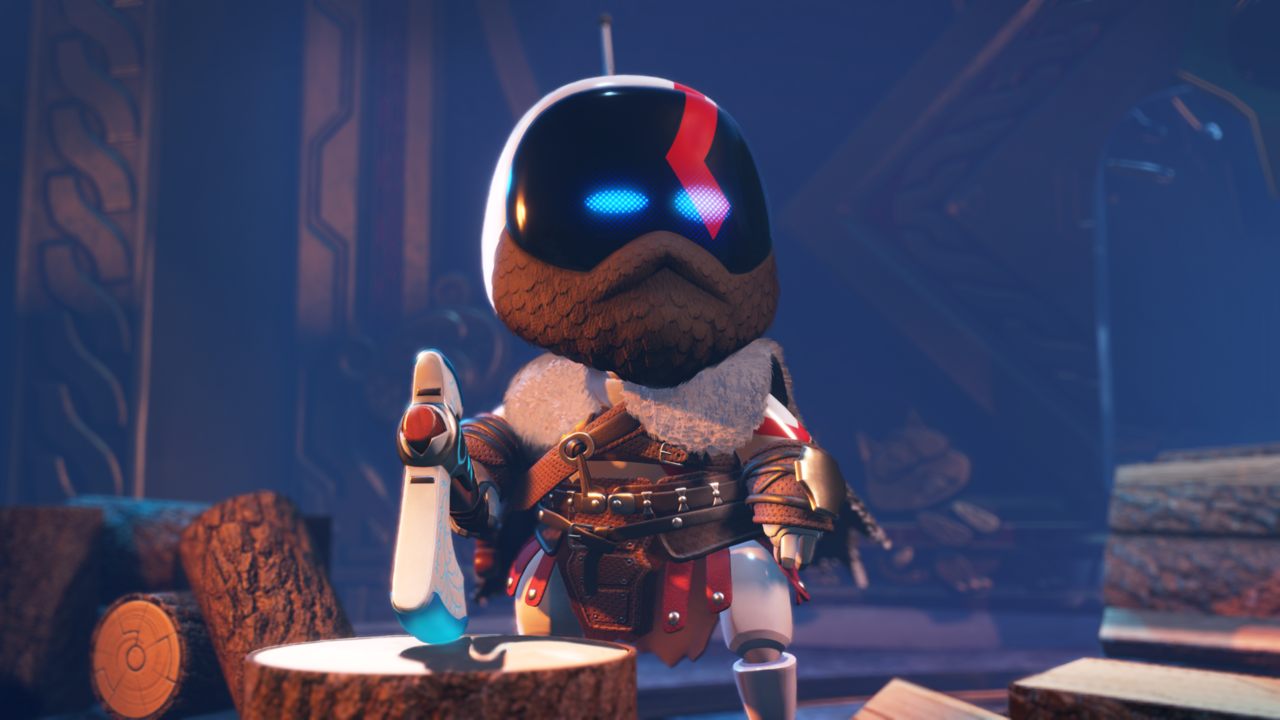For multiple console life cycles, PlayStation has fostered a brand built on gritty anti-heroes, fantastical worlds at conflict with themselves, and a trope colloquially referred to as “sad dads.” I like most of those games and find the praise they receive in many cases to be well-earned, but Astro Bot is a reminder of another side to the PlayStation DNA. Not only does it feel like a revitalization of an important part of the brand, but it also feels like a spotlight shifting to a character who has been lurking in the background, previously unable to see over the hulking Kratos, the war-ready Aloy, or the tortured Joel. Team Asobi’s Astro Bot quickly, consistently, and joyously launches its titular hero into the pantheon of all-time greats, both in its first-party family and genre, with a platformer whose incredible ambition is matched by its brilliant execution.
Stranded in space following an attack from a googly-eyed alien, Astro’s mission is to repair their ship and rescue all 300 pals scattered across five main clusters of planets, each composed of individual levels. Naturally, the story is not the focus here, and yet I was so immersed in the 15-hour game that I beat it in two long sittings. It may be 2024’s most immersive game, and it achieves that without a line of dialogue. Instead, each level tells a story, clear as day, about where you ought to go next and what you should do there.
There is both depth and breadth to most levels, and frequent checkpoints mean you’ll rarely be punished for exploration or missing a jump. Levels take only five to 10 minutes in most cases, but are overflowing with personality. Robot animals climb trees along the periphery or jump out of the ocean far beneath the levitating worlds you explore. Everything constantly moves around you, imbuing every level with life beyond the scraps you’ll engage in with the game’s enemies. Each level’s theme is brought to life with aesthetic assets and design ideas that strengthen their themes. During a Japan-themed level in which Astro can soak up water to become something like a giant squishy kaiju, you’ll simply plow over enemies the robot would otherwise need to be wary of, topple bamboo walls as the ground shakes around you, and soak in hot springs, all while string music evokes the country’s signature sounds.
In another that sees Astro shrink to the size of a mouse, the miniature world reveals new woodsy and backyard-like scenery that regular-sized Astro couldn’t reach. Because of the game’s Smash Bros-like manner of bringing in dozens of familiar faces, some levels purposely evoke multiple games at once, like a desert level that is titled like and starts off like a Prince of Persia reference before ultimately ending with an ascent to a glorious mountaintop a la Journey. Some levels even drastically change the art style, as seen in a series of voxel-art levels I was glad to discover each time, or some others I dare not spoil.
Numerous dazzling aesthetics in Astro Bot are somehow only used once or very little, like a casino level with bright multicolored lights and betting chips floating through the sky, or a level meant to look like a child-friendly haunted graveyard and nearby castle, which is among my favorites in the whole game but–again–somehow is featured just once. These assets surely take many human hours to make, and again, Astro Bot presents them with the confidence to wordlessly suggest, “Yeah, we know these rule, but look what else we have for you,” before the next level wipes the slate and starts anew with yet another never-before-seen aesthetic. I haven’t seen a platformer marathon through so many varied, whimsical, and blatantly cool ideas like this before.
My favorite aspect of the game is how it seems to read my mind. Every time I’d divert off the main path in search of a secret or reward, I would find one. Team Asobi understands its level-design concepts so well that it can reliably predict where and when players will get sidetracked, and it ensures there’s always something waiting there for them, like a surprise gift in the mail whose sender can’t wait to learn it’s arrived. “Can I climb this crane?” I’d wonder to myself. Yes, I can, and for scaling it to the very top I’d find coins to spend on cosmetics. “What if I peek over this ledge?” There’s a hidden cave below, hiding another puzzle piece used to open shops in the game’s hub world. Whenever I’d wonder if my intuition was leading me to something valuable, I’d find I was right.
In tandem with expert level design are the game’s diverse and exciting mechanics. At the start of nearly every level, Astro jumps into a suit or straps on a backpack of some kind that gives them a new ability. In one level, it’s spring-powered boxing gloves resembling cartoon frogs. In another, it’s a robo-dog that gives the bipedal bot a wall-smashing rocket boost, or in another, a time-freezing tool that allows Astro to scale otherwise impossibly fast-moving sections. Across the game’s dozens of levels, you’ll see many abilities like these, and in nearly every case, they are a resounding success.
While some abilities are more fun than others, they nearly all work seamlessly. As Astro, you’ll strap on the ability and intuitively understand it. You sense its limitations and use cases immediately, and though the game disposes of abilities at an uncommon pace, many will resurface later in a new setting or be used to defeat the game’s fun bosses–including a final boss and credits sequence that will surely go down as one of 2024’s best video game moments.
Even within a level, an ability is used in several different and creative ways, but always stemming from its singular mechanic featured in that level. It ramps up the platforming and combat sequences via an approachable but challenging incline and chains these little moments together in such a way that there’s never a lull in any level. Whereas many platformers may drill down on a key feature or small set of features, Astro Bot displays confidence by often disposing of exciting new tools shortly after introducing them. It expresses iteration in cycles of five minutes each, rather than iterating on one idea for five or more hours, which I find both refreshing and bold. The only other game I’ve seen that’s similarly willing to dispose of cool ideas like this is It Takes Two, and Astro Bot does it more often and with more enjoyable mechanics.
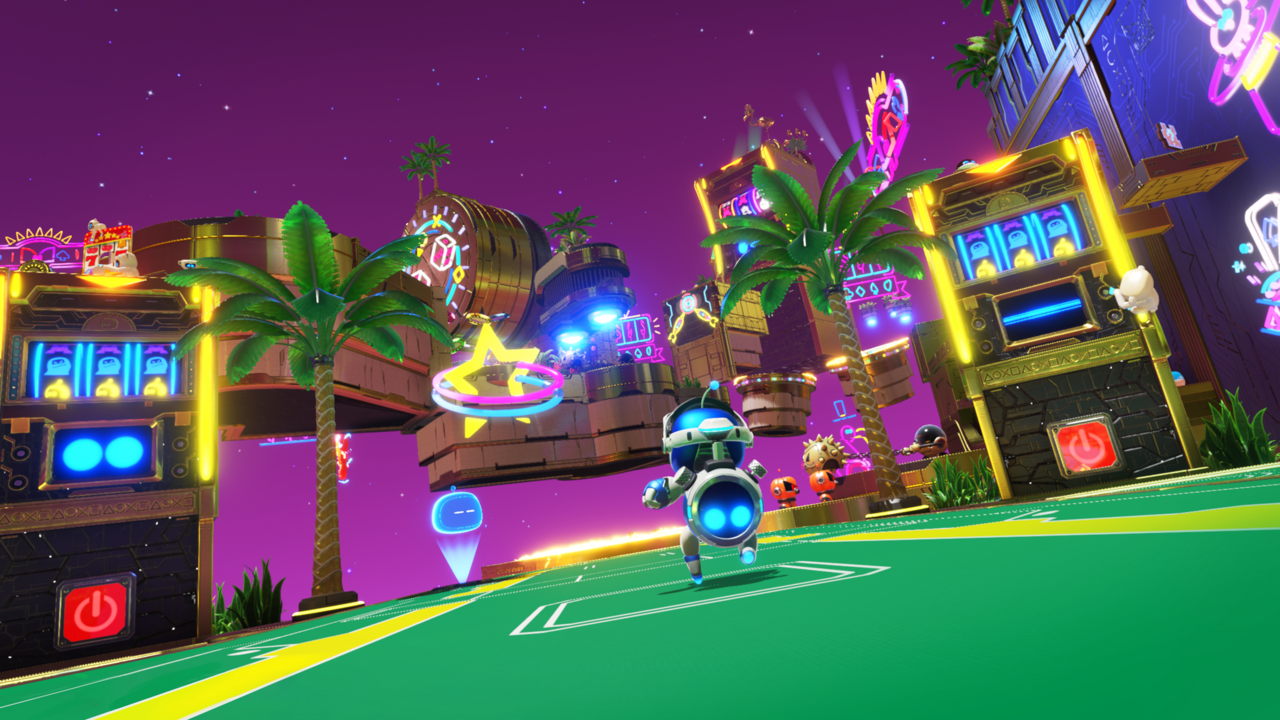
Like any excellent platformer, Astro Bot’s movement feels responsive and trustworthy. Despite the game consistently giving you new ways to traverse its puzzling pathways, you’ll almost always feel like you have a good grip on clearing gaps, timing attacks on enemies, and dodging bosses with expertise. The camera caused a few rare instances of what felt like selling me out, but the game’s checkpoints are so numerous and the load times are virtually non-existent, such that this never became a pain point for me.
The only ability that doesn’t work as cleanly as others is the one used in an underwater level. Meant to mimic a dolphin-like dive ability, the controls used for this one never feel as intuitive as those for other abilities. In this level, I found it unusually tricky, albeit not exactly difficult, to collect all the secrets. A few of them demanded a deft diving ability the backpack is meant to offer, but it doesn’t have the same accuracy of other abilities in the game, which led me to whiff on some sections in a way that was unique to this level. It was manageable, but if any secret levels–which tend to be some of the game’s hardest–also use this mechanic, I expect them to become some of the game’s few frustrations.
In the few instances where the hero isn’t wearing an ability, the game still finds ways to reinvent itself. A mid-game level that evokes the kid-friendly vibes of a preschool presents a clever day-and-night-switching mechanic that tosses the world on its side back and forth whenever you press a button, allowing Astro to solve puzzles and reach the end. But once that awesome level was finished, I never saw the mechanic used again. Astro Bot feels like it’s showing off at times, but never in a way that pats itself on its back. It’s ceaselessly cute and clever, and feels more like a little kid delighted to show you their toy collection than a braggart displaying their trophies.
Each galaxy you arrive in houses several secrets to uncover in the overworld, and even levels themselves have hidden bonus stages. This game’s secrets have secrets, with more hidden levels being revealed at a steady clip whenever you inch closer to polishing off each galaxy’s to-do list. The best of those secrets are the hidden bots themselves. There are 300 in total, though you only need 200 to face the final boss, and over half of them are dressed up as iconic characters from video game history. Many of these are first-party heroes, like Ellie and a Gran Turismo racer, but many others are cameos of characters from series closely tied to PlayStation’s past, such as Tomb Raider, Persona, or even classic and contemporary indies like Journey, Stray, and Humanity.
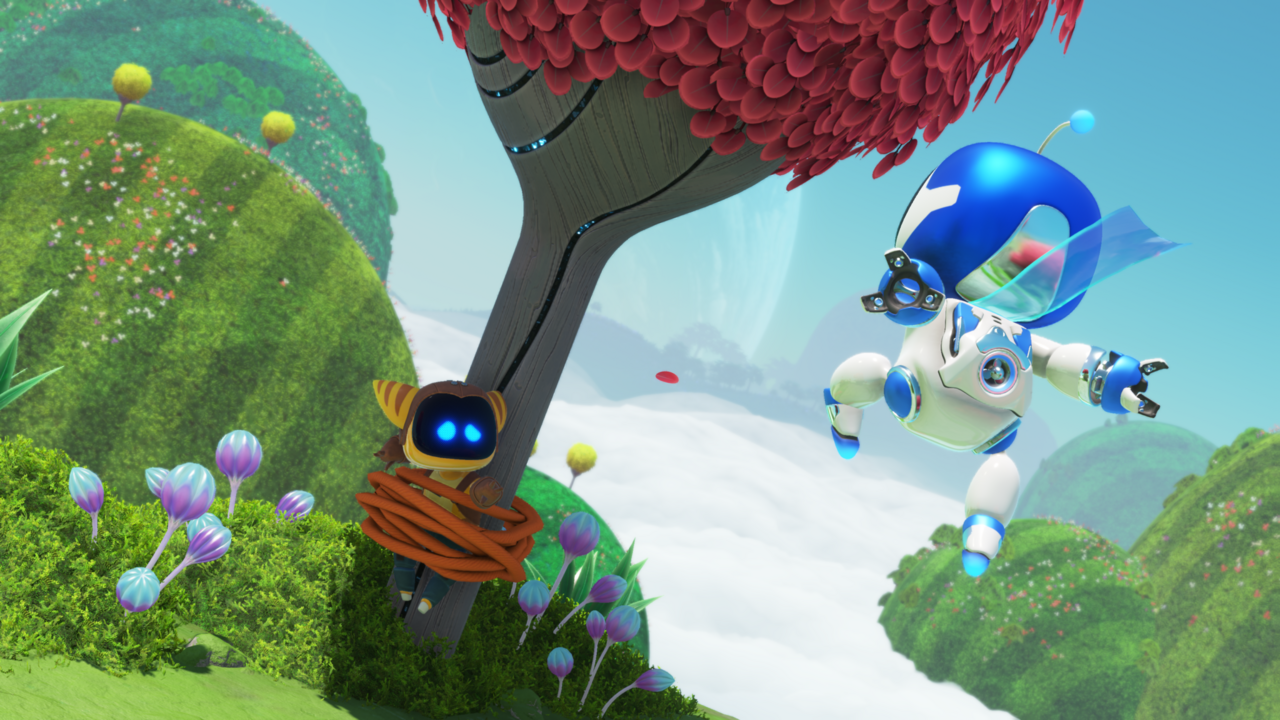
Each bot you find returns to the (mostly) safe zone, the Crash Site, which acts like a hub world you can explore and decorate. Here, the game carries forward the same PlayStation Museum vibe seen in Astro’s Playroom, albeit to a lesser extent. You won’t explore past PlayStation consoles, but the mothership you’re trying to repair is just a giant PS5, and the spaceship you use to explore the overworld is a DualSense controller with wings. It feels a bit like that meme of Obama awarding Obama a medal, but it’s not distracting, so ultimately, it’s fine.
Spending coins in the game’s shop unlocks dioramas, ship paints, and costumes for Astro, even some based on unexpected series such as Bloodborne and Gravity Rush. The dioramas are especially fun, as they turn all your collected bots into animated statues, like one that shows Nathan Drake playing a game called Dude Raider on his couch. Even the most serious of characters are turned into caricatures, like a scene you can create in which The Last of Us’ Joel goes to throw a brick, but it slips out of his hand and bonks him on the head. All of the 169 cameo bots fill in the would-be barren desert sands like a virtual shelf of Funko Pops.
Finding each of these characters is a constant highlight of Astro Bot. Some are placed right in front of you, but most require the aforementioned curiosity to pull you off the beaten path in search of the game’s bountiful secrets. One of the best mechanics–which I very much hope becomes standard in the genre moving forward–is a robot bird companion who can join you in any level you decide to replay. The bird pings for collectibles and leads you right to the remaining bots, secret Void levels, and puzzle pieces you’ve not yet found. This makes playing the game to 100% completion a joy and never a grind. I’ve never cared about PlayStation Trophies before, but I expect to unlock them all in Astro Bot, if only incidentally because I want to see and do everything this game offers.
It seems odd to say I don’t want to spoil a game that effectively has no story, but some of the game’s best secrets really must be discovered with your own eyes. To talk around Astro Bot’s most entertaining of these surprises, I’ll mention that it will occasionally rethink its mechanics as a whole, nearly swapping genres at times, in ways that pay homage to PlayStation’s illustrious past. These special levels arrive toward the end of each galaxy’s main mission path and bestow to you a bundle of themed bots as well as yet another cool new mechanic not to be seen ever again in the game. Its soundtrack–already an array of bubbly earworms–reimagines familiar overtures from other games. In doing all of this for these most-special one-offs, the promise of its world comes into full view. Astro Bot swarms the player with bright ideas, sparking almost endless joy.
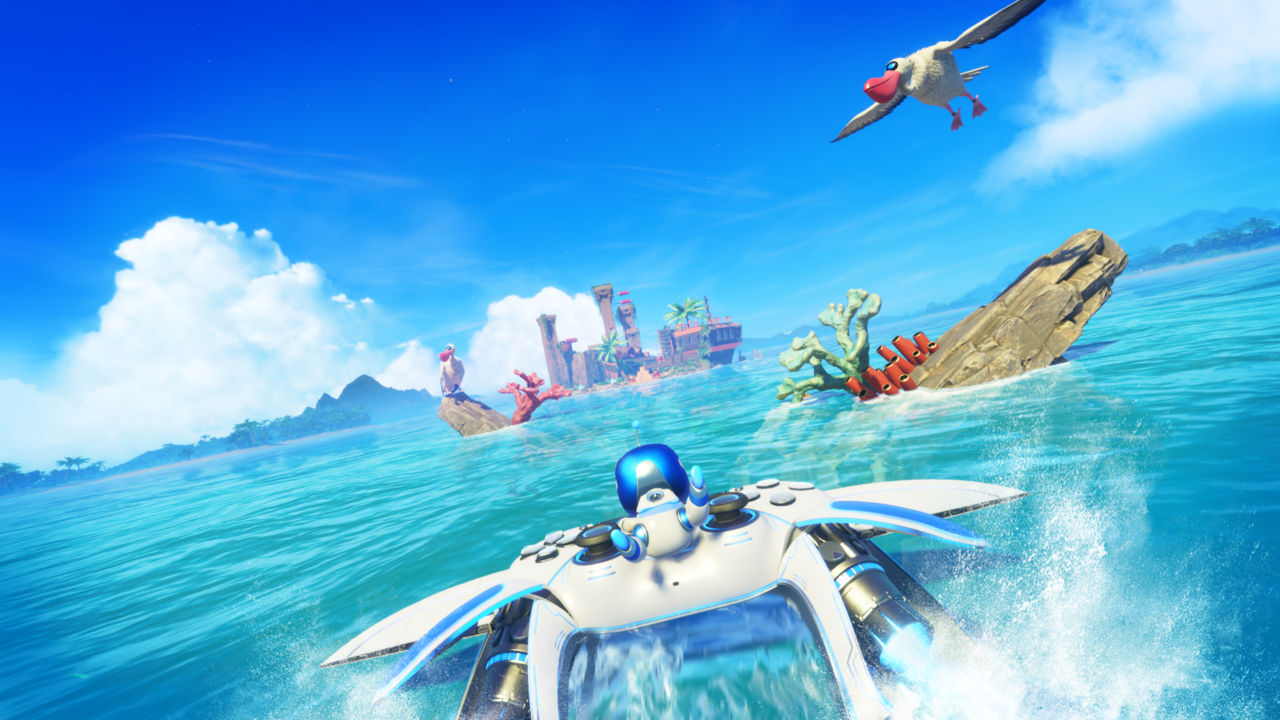
Astro Bot is also meant to be a DualSense showcase, and it certainly does a lot there, though I continue to feel like the controller’s most passionate fans are within the company itself. I don’t mind the DualSense, but I don’t feel like much would be lost if I played the game without features like secondary noises coming out of my controller, blowing air into it to propel a fan, or using the gyroscopic motion controls to physically repair the ship each time I finished a galaxy and found another elusive ship part.
Its best attribute, a rumble feature more nuanced than what other controllers provide, is also simpler than all of the DualSense’s high-end abilities that sometimes come off as gimmicky. Astro Bot also did away with some of them from Astro’s Playroom, such as using the center touchpad to unzip some blockades. Instead, this is done with the joystick, suggesting Team Asobi found it best to keep players’ hands off the somewhat clunky touchpad this time around.
Beyond the underwater level that doesn’t shine the way others do, my only other frustrations with Astro Bot come in the form of some of the game’s hardest levels, which will likely be too difficult for younger or less-experienced players. Normally, these levels are as brief as 30 seconds, but they require perfection and give the game a taste of trial-and-error it otherwise consciously rejects.
I understand the game is split into tiers, allowing most anyone to be able to beat the base game before the diehards go the extra mile, but since several cameo characters are locked behind these ultra-hard mini-levels, it’s a bit of a letdown that some of the game’s younger fans may likely never find all of the must-have bots to bring back to their hub world. In this way, Astro Bot gates a small but not insignificant portion of its best material behind a skill check that some of its audience won’t pass.
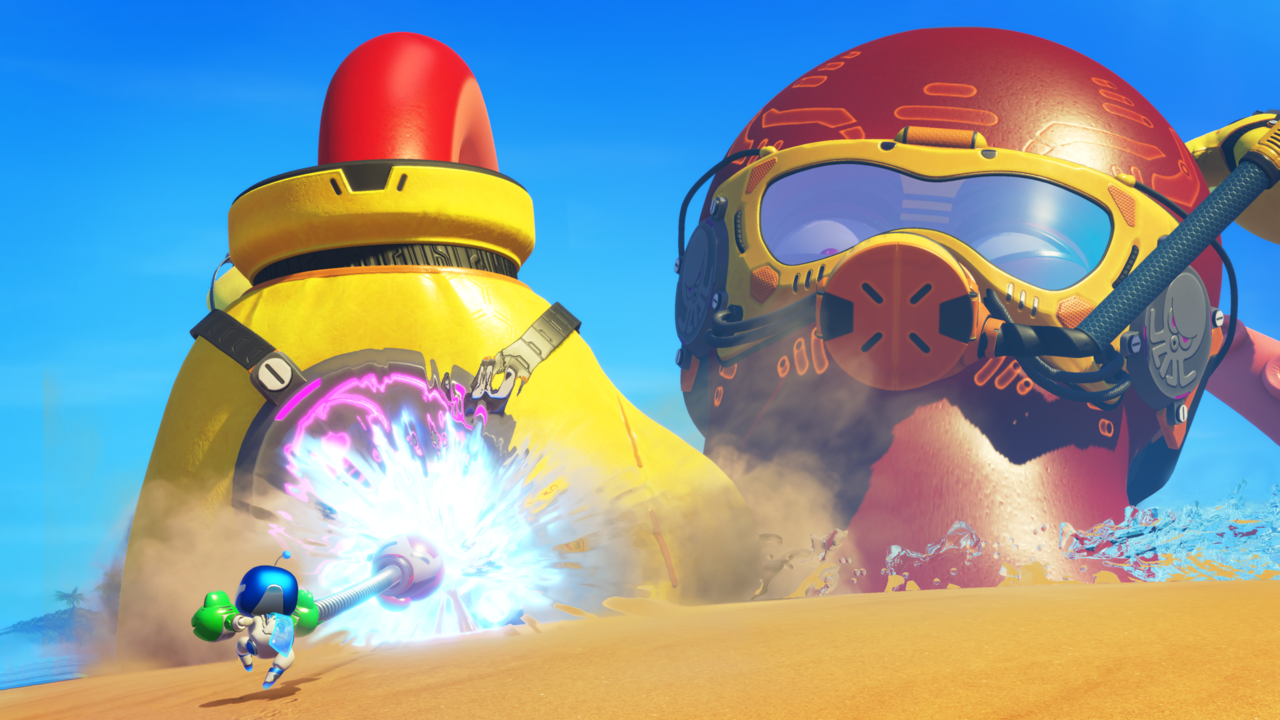
Gallery
The game also crashed on me twice, both times erasing more progress than I’d have expected since I assumed it auto-saves after each level, but I’d lost about three or four levels of progress in both instances. However, I admit these crashes came at the end of my long 11-hour session with the game on my first day with it, so maybe it was an issue Team Asobi will address. Still, the hard crash backpedaling on my saved data was strange and somewhat soured what was a marathon of smiles for about 10 hours of that day.
The simply titled Astro Bot is meant to be the cute robot’s first significant foray into video games following a 2018 VR exclusive that earned praise but was stuck in its headset-only bubble, and a 2020 pack-in tech demo that hinted at more to come. The beauty of the game, as suggested by its title, is that even players returning for their third Astro adventure will find hours upon hours of new experiences, collectively and magnificently presented as a parade of joyous sights, sounds, and adventures. This is a grand re-opening for Astro Bot, and it surely marks the start of what is destined to be a beloved series shooting for the moon.
